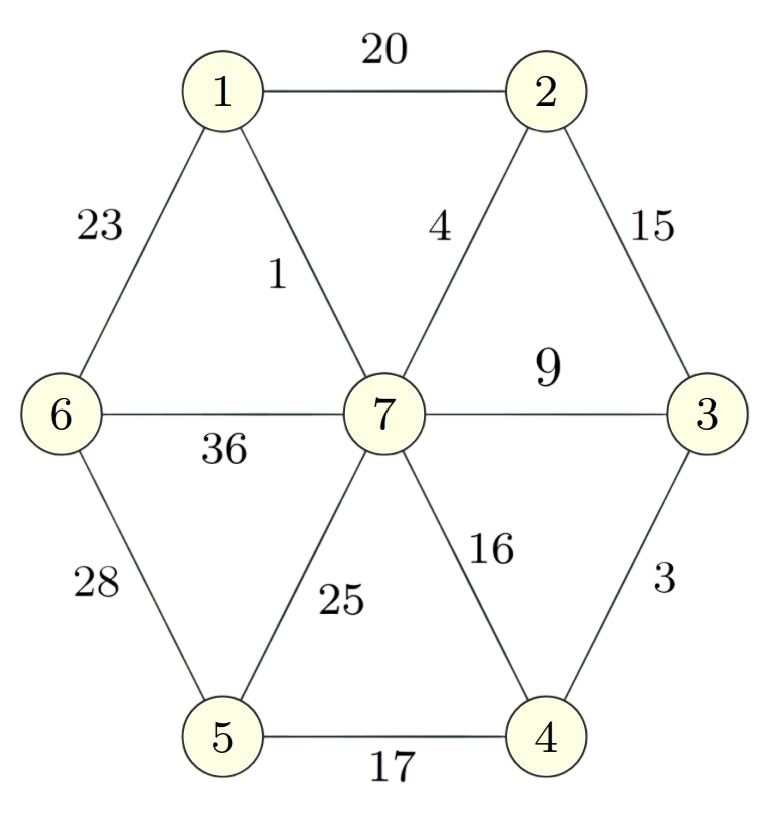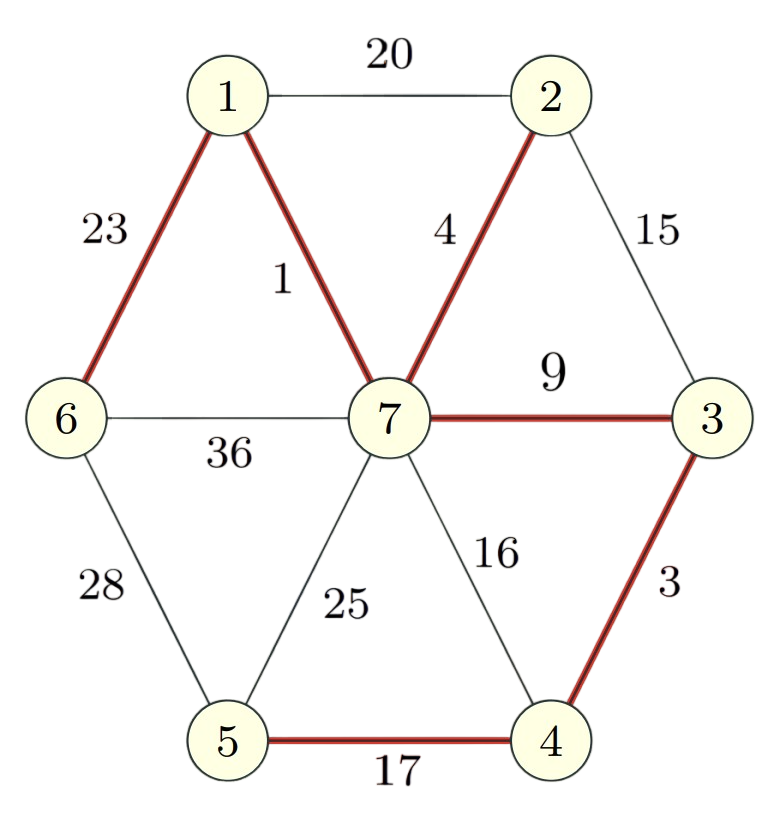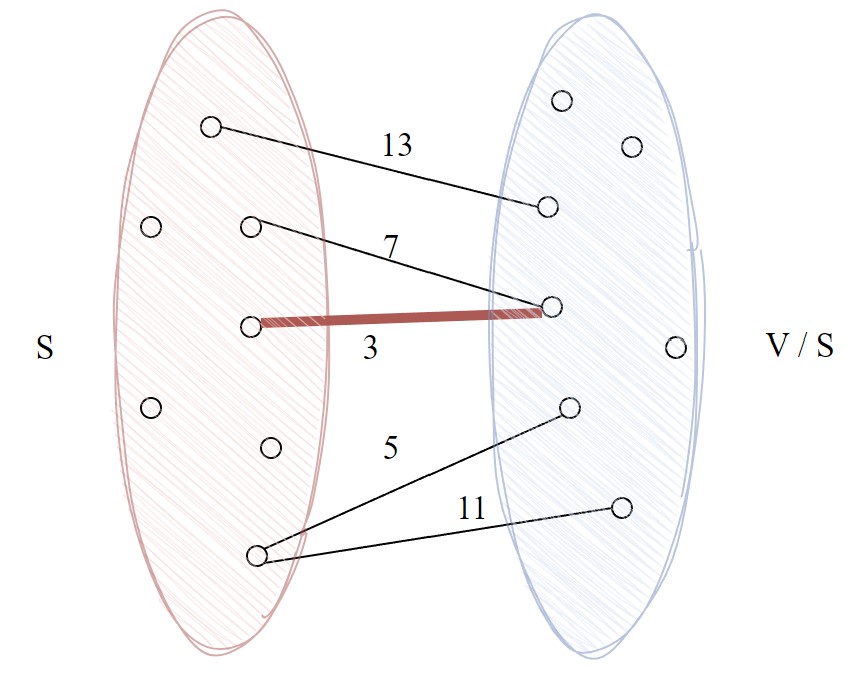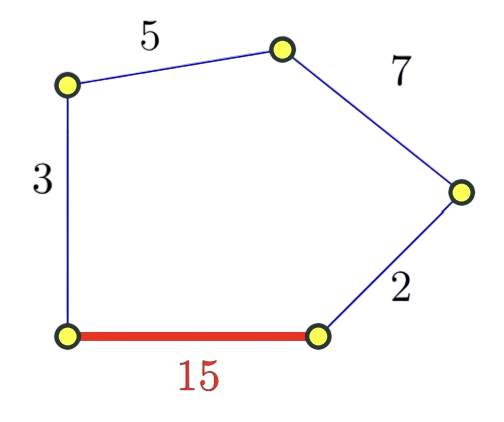Minimum Spanning Trees
Definition
- Input : Connected graph G = (V, E) with edge costs
- Goal : Find T $\subseteq$ E such that (V, T) is connected and total cost of all edges in T is smallest. T is then the minimum spanning tree (MST) of G.
Example:

|

|

|
Applications
- Network Design
- Designing networks with minimum cost but maximum connectivity
- Approximation algorithms
- Can be used to bound the optimality of algorithms to approximate Traveling Salesman Problem, Steiner Trees,etc.
- Cluster Analysis
Basic Properties
- Tree = undirected graph in which any two vertices are connected by exactly one path.
- Tree = a connected graph with no cycles.
- Subgraph H of G is spanning for G, if G and H have same connected components.
- A graph G is connected $\Longleftrightarrow$ it has a spanning tree.
- Every tree has a leaf (i.e., vertex of degree one).
- Every spanning tree of a graph on n nodes has n − 1 edges.
Cuts
Given a graph G = (V, E), a cut is a partition of the vertices of the graph into two sets (S, V \ S).
- Edges having an endpoint on both sides are the edges of the cut.
- A cut edge is crossing the cut.
-
(S, V \ S) = {uv $\in$ E u $\in$ S, v $\in$ V \ S}.
Safe and Unsafe edges
Safe edge
- Definition: An edge e = (u, v) is a safe edge if there is some partition of V into S and V \ S and e is the unique minimum cost edge crossing S (one end in S and the other in V \ S).
- So, every cut identifies one safe edge, the cheapest edge in the cut.
- Note that an edge e may be a safe edge for many cuts.
- For example: In the below graph, the edge marked in red is a safe edge in the cut (S, V\S)

Unsafe edge
- Definition: An edge e = (u, v) is an unsafe edge if there is some cycle C such that e is the unique maximum cost edge in C.
- So, every cycle identifies one unsafe edge, the most expensive edge in the cycle.
- Example :

- If edge costs are distinct then every edge is either safe or unsafe
Spanning tree properties
- If e is a safe edge then every minimum spanning tree contains e.
- Suppose e = (v,w) is not in MST T and e is min weight edge in cut (S, V \ S). Assume v ∈ S. Then, T’ = (T \ {e’}) $\cup$ {e} is a spanning tree.
- The safe edges form the MST
- Let G be a connected graph with distinct edge costs, then the set of safe edges does not contain a cycle.
- Let G be a connected graph with distinct edge costs, then set of safe edges form the unique MST of G.
- The unsafe edges are not in the MST
- If e is an unsafe edge then no MST of G contains e.
Algorithms
- Borůvka’s Algorithm
T is ∅ (* T will store edges of a MST *) while T is not spanning do X ← ∅ for each connected component S of T do add to X the cheapest edge between S and V \ S Add edges in X to T return the set TRunning time: O(m log n) time
- Kruskals Algorithm
Kruskal_ComputeMST Initially E is the set of all edges in G T is empty (* T will store edges of a MST *) while E is not empty do choose e ∈ E of minimum cost if (T ∪ {e} does not have cycles) add e to T return the set TRunning time: O(m log m) + O(mn) = O(mn)
- Prim’s Algorithm
Prim_ComputeMST E is the set of all edges in G S = {1} T is empty (* T will store edges of a MST *) while S 6= V do pick e = (v,w) ∈ E such that v ∈ S and w ∈ V \ S e has minimum cost T = T ∪ e S = S ∪ w return the set TRunning time: O(nm)
- Prim’s Algorithm using Priority Queues
Prim_ComputeMSTv3 T ← ∅, S ← ∅, s ← 1 ∀v ∈ V (G) : d(v) ← ∞, p(v) ← Nil d(s) ← 0 while S 6= V do v = arg min u∈ V\S d(u) T = T ∪ {vp(v)} S = S ∪ {v} for each u in Adj(v) do d(u) ← min {d(u), c(vu)} if d(u) = c(vu) then p(u) ← v return T
Additional Resources
- Textbooks
- Erickson, Jeff. Algorithms
- Skiena, Steven. The Algorithms Design Manual
- Chapter 8.1 - Minimum Spanning Trees
- Sedgewick, Robert and Wayne, Kevin. Algorithms (Forth Edition)
- Chapter 4.3 - Minimum Spanning Trees
- Cormen, Thomas, et al. Algorithms (Forth Edition)
- Chapter 21 - Minimum Spanning Trees
- Jeff’s Textbook - Minimum Spanning Trees
- Sariel’s Lecture 20

